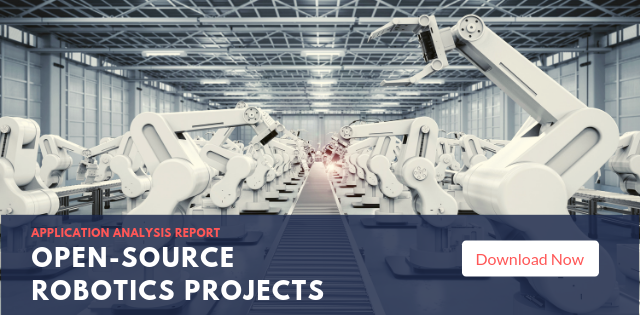As robots become more commonplace in commercial and industrial settings, companies are searching for ways to optimize how robots behave and interact with one another.
It’s no wonder, then, that our data shows an explosion in the adoption of the Robot Operating System. In fact, according to our new Open-Source Robotics Projects report, nearly 55% of commercial robots shipped by 2024 will have at least one ROS package onboard. That represents 915,000 units, and is paving the way for ROS to become the industry standard for robotics middleware.
What Is The Robot Operating System (ROS)?
The Robot Operating System (ROS) is a flexible and collaborative open-source framework for building operating systems for robotics.
The development of any robotic operating system requires a thorough understanding of systems engineering techniques, knowledge of design goals, and adherence to a rigorous development process. As a result, early robotics developers and implementors would often struggle to finance their efforts without the support of large academic or corporate entities.
The emergence of an open-source framework like ROS has allowed robotics developers and implementors to create proprietary robotics systems based on in-house skills and publicly available robotics middlewares, simulators, libraries, and toolkits.
The Next Evolution Of ROS
ROS's success has been driven largely by its wide range of interoperability. The operating system is compatible with many other open-source projects, such as Orocos for real-time communication and OpenCV for machine vision models.
Now Open Robotics, the organization behind ROS, is trying to make the system even more flexible and valuable as ROS evolves from version 1.0 to version 2.0. ROS 2.0 incorporates support for multi-robot systems, real-time communications, non-ideal networks, and computing capabilities. This makes ROS 2.0 not only more user-friendly, robust, and real-time, but also makes it readier to be accepted as an industry standard – and it's a standard that is already taking hold.
In Singapore, the government has partnered with Open Robotics to launch the Robotics Middleware Framework (RMF) for Healthcare Using ROS as a common platform, local healthcare was able to onboard and integrate various robotics systems based on the same framework, thereby extending interoperability to proprietary systems and protocols.
Moving forward, ROS needs to ensure it continues to expand support from OS vendors such as Microsoft, cloud vendors such as Amazon and Google, component vendors such as Robotiq, and system integrators and implementers in order to become a widely accepted industry standard. In the case of RMF, regulatory bodies and policymakers play important roles in the adoption of ROS. That said, this will not spell the end of proprietary robotics systems.
In fact, there will be co-existence of both open-source and closed robotics systems. Aside from niche systems that may be better served by proprietary systems, ROS will serve as the fundamental building block for interoperability, with customization and enhancement introduced on top by different robotics system vendors.
The success of ROS has also driven more investment into hardware related open-source robotics project. In recent years, major industry players like Comau and NVIDIA have launched ROS-based, open-source robotics hardware platforms. While the platforms are mainly for research and educational purposes, the involvement of major corporations will certainly drive more attention to the open-source community, bringing in more developers and end users.
In-Depth ROS Research
For a comprehensive look into ROS and the open-source robotics landscape, download our application analysis report,

